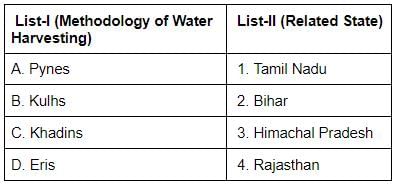Test: Class 10 General Science NCERT Based - 4 - UPSC MCQ
30 Questions MCQ Test - Test: Class 10 General Science NCERT Based - 4
Different sources are used in India to meet the energy requirement. Depending on the consumption of energy from different sources, select the correct answer from the code given below in descending order:
Consider the following statements:
1. Hydro power plants convert the potential energy of falling water into electricity.
2. Construction of big dams generates greenhouse gas.
Which of the statements given above is/are correct?
Consider the following statements:
1. The fuels which are produced by plants and animals are called biomass.
2. The main Constituent of Biogas is Methane.
Which of the statements given above is/are correct?
The slurry left behind in a biogas plant, contains which of the following elements?
Which of the following countries is called the country of 'winds'?
Which of the following elements is/are used in making solar cells?
1. Silicon
2. Astatine
3. Sirium
4. Vanadium
Sea energy can be converted into electricity in ocean-thermal-energy-conversion plants when–
Consider the following statements:
1. In the nuclear fission, the nucleus of a heavy atom can be split apart into lighter nuclei.
2. In a nuclear reactor designed for electric power generation, nuclear ‘fuel’ releases energy at a controlled rate.
Which of the statements given above is/are correct?
Match List-I with List-II and select the correct answer using the code given below:
List-I (Nuclear power reactors)
A. Kalpakkam
B. Narora
C. Kakrapar
D. Tarapur
List-II (States)
1. Uttar Pradesh
2. Gujarat
3. Tamil Nadu
4. Maharashtra

With reference to nuclear fusion, consider the following statements:
1. During the nuclear fusion reaction two lighter nuclei are joined to make a heavier nucleus.
2. Nuclear fusion reactions take place in the Sun and Star. It takes considerable energy to force the nuclei to fuse.
Which of the statements given above is/are correct?
Which of the following statements best describes the term ecosystem?
Which of the following ecosystems is/are examples of natural ecosystems?
1. Ponds
2. Lakes
3. Crop-fields
4. Gardens
Select the correct answer using the code given below:
Regarding the producers, consider the following statements:
1. They make organic compounds from inorganic substances in the presence of sunlight and chlorophyll.
2. Fungi are Heterotrophs.
Which of the statements given below is/are correct?
Regarding the categories of consumers in the ecosystem, which of the following types of organisms are called decomposers?
1. Virus
2. Bacteria
3. Fungus
Regarding a food chain in an ecosystem, consider the following statements:
1. Food chain involves flow of energy from one component of the system to another.
2. The Food chain demonstrates the numbers of every organism that are eaten by others in line.
Which of the statements given above is/are correct?
Consider the following statements:
1. Producers convert solar energy into chemical energy.
2. The flow of energy is unidirectional in the food chain.
3. The green plants in a terrestrial ecosystem capture about 100% of the energy of sunlight that falls on their leaves and convert it into food energy.
Which of the statements given below is/are correct?
What is the average value for the amount of organic matter that is present at each step and reaches the next level of consumers?
Which of the following statements defines Biological Magnification?
Regarding the ozone layer, consider the following statements:
1. Ozone (O3) is a molecule formed by three atoms of oxygen.
2. Ozone shields the surface of the earth from ultraviolet radiation from the Sun.
3. Human synthesized chemicals such as chlorofluorocarbons (CFCs) have started declining the amount of ozone.
Which of the statements given above is/are correct?
Hydrogen bomb is based on which of the following reactions?
The Ganga Action Plan was first introduced in which of the following years?
Amrita Devi Bishnoi National Award is given in which of the following fields?
Consider the following statements:
1. The Chipko movement is associated with forest conservation.
2. The Chipko movement originated from Himachal Pradesh.
3. The Chipko movement began during the early 1970s.
Which of the statements given above is/are correct?
Consider the following statements:
1. Coal and Petroleum have been derived from inorganic sources.
2. Carbon monoxide is the byproduct of limited supply of oxygen during combustion.
Which of the statements given above is/are correct?
Which of the following does not lead to the depletion of groundwater?
Among the following choose the correct option which includes acts related to the three R's strategy which can be useful for conserving our natural resources?
In our country, there are attempts to increase the height of several existing dams like Tehri and Almatti dams across the Narmada. Choose the correct statements among the following that are a consequence of raising the height of dams
1. Terrestrial flora and fauna of the area is destroyed completely
2. Dislocation of people and domestic animals living in the area
3. Valuable agricultural land may be permanently lost
4. It will generate permanent employment for people
Choose the correct option from the following:
Given below are a few statements related to biodiversity. Pick those that correctly describe the concept of biodiversity
1. Biodiversity refers to the different species of flora and fauna present in an area
2. Biodiversity refers to only the flora of a given area
3. Biodiversity is greater in a forest
4. Biodiversity refers to the total number of individuals of a particular species living in an area
Choose the correct option from the following:
Which among the statements given below is incorrect?
















